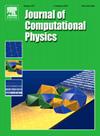Ensemble variational Fokker-Planck methods for data assimilation
IF 3.8
2区 物理与天体物理
Q2 COMPUTER SCIENCE, INTERDISCIPLINARY APPLICATIONS
引用次数: 0
Abstract
Particle flow filters solve Bayesian inference problems by smoothly transforming a set of particles into samples from the posterior distribution. Particles move in state space under the flow of an McKean-Vlasov-Itô process. This work introduces the Variational Fokker-Planck (VFP) framework for data assimilation, a general approach that includes previously known particle flow filters as special cases. The McKean-Vlasov-Itô process that transforms particles is defined via an optimal drift that depends on the selected diffusion term. It is established that the underlying probability density - sampled by the ensemble of particles - converges to the Bayesian posterior probability density. For a finite number of particles the optimal drift contains a regularization term that nudges particles toward becoming independent random variables. Based on this analysis, we derive computationally-feasible approximate regularization approaches that penalize the mutual information between pairs of particles, and avoid particle collapse. Moreover, the diffusion plays a role akin to a particle rejuvenation approach that aims to alleviate particle collapse. The VFP framework is very flexible. Different assumptions on prior and intermediate probability distributions can be used to implement the optimal drift, and localization and covariance shrinkage can be applied to alleviate the curse of dimensionality. A robust implicit-explicit method is discussed for the efficient integration of stiff McKean-Vlasov-Itô processes. The effectiveness of the VFP framework is demonstrated on three progressively more challenging test problems, namely the Lorenz '63, Lorenz '96 and the quasi-geostrophic equations.

求助全文
约1分钟内获得全文
求助全文
来源期刊

Journal of Computational Physics
物理-计算机:跨学科应用
CiteScore
7.60
自引率
14.60%
发文量
763
审稿时长
5.8 months
期刊介绍:
Journal of Computational Physics thoroughly treats the computational aspects of physical problems, presenting techniques for the numerical solution of mathematical equations arising in all areas of physics. The journal seeks to emphasize methods that cross disciplinary boundaries.
The Journal of Computational Physics also publishes short notes of 4 pages or less (including figures, tables, and references but excluding title pages). Letters to the Editor commenting on articles already published in this Journal will also be considered. Neither notes nor letters should have an abstract.
 求助内容:
求助内容: 应助结果提醒方式:
应助结果提醒方式:


